Cambrian Fossils in the Bright Angel Shale
of Northern Arizona:
"SW"
Locality
Site
and Key
Trilobite
Fossils Section
|
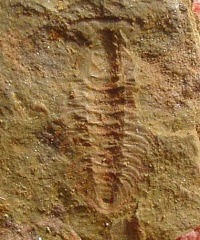 The dominant trilobite at
this site - Zacanthoides.
The dominant trilobite at
this site - Zacanthoides.
|
Updated 6/7/17
 |
This site, located
south of the Grand Canyon is one of two BAS localities in which
we found locally abundant fossils. They are preserved as highly
detailed molds, occuring in dense layers 1 - 2 inches thick.
Finding the correct shale horizon is the trick here, then that
layer is worked horizontally. Underlying the trilobite layer
is a mass mortality layer of an unidentified colonial animal,
and a nearby hill is a higher section in the stratographic column
which contained only trace fossils at the base, and the Muav
Limestone at the top which contained no fossils.
Note: All images
are small thumbnails, click for a full size image!
|
Site Images:
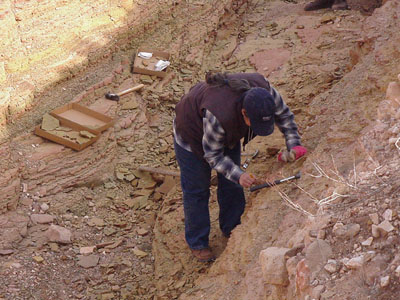 Click for a full size image!
Click for a full size image!
|
Paleontologist Rose Fowers splitting shales, and taking precise measurements.
The shales are green and slightly micaceous in nature, and the fossiliferous horizons
are usually a few inches thick separated by non fossiliferous zones. Fossils are found
as external molds of dorsal and ventral impressions, and also as calcareous replacement
of small delicate specimens. Whole trilobites are rare, and as usual - most are molts.
|
Key Fossils:
Trilobites - Complete or nearly complete specimens Type 1 - Zacanthoides walapai
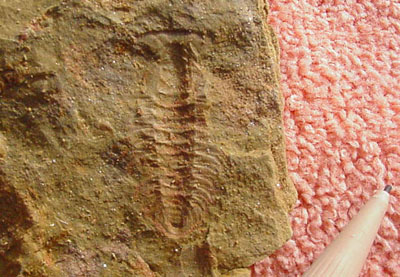 Click for a full size image!
Click for a full size image!
|
Two types of trilobites are found here. This is "Type 1", and we have found
several complete specimens. This one is missing the huge free cheeks and
stubby genial spines.
|
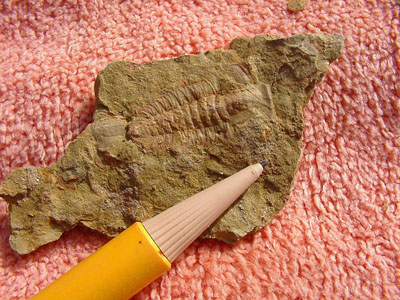 Click for a full size image!
Click for a full size image!
|
Another nearly complete specimen minus one free cheek and both genial spines.
|
 Click for a full size image!
Click for a full size image!
|
Highly flattened specimen, with both cheeks but missing parts of the
cranidium and genial spines.
|
 Click for a full size image!
Click for a full size image!
|
This slightly distorted specimen only missing one side of the cephalon shows relatively short
genial spines and how oversize the cephalon is compared to the highly tapering thorax. The
eye lenses are apparent on this one!
|
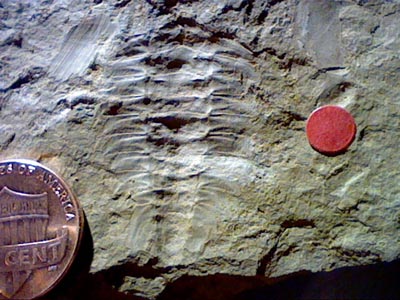 Click for a full size image!
Click for a full size image!
|
A nice thorax and pygidium I found, the red dot is 1/4" diameter.
|
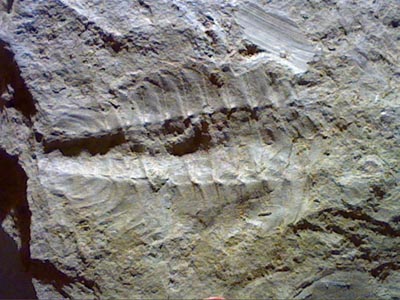 Click for a full size image!
Click for a full size image!
|
Thorax and pygidium of another type 1 that we collected.
|
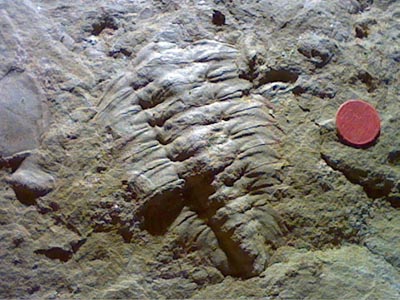 Click for a full size image!
Click for a full size image!
|
Thorax and pygidium in a partially enrolled state.
|
Trilobites - Reconstruction of individual Exuvia - Type 1
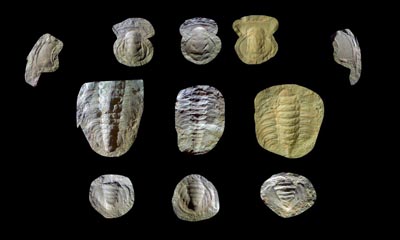 Click for a full size image!
Click for a full size image!
|
I took some of the better parts we found and layed them out so you can see
the taphonomic preservational variation in a single species. Top we have
cranidiums, center thorax, and bottom pygidiums.
|
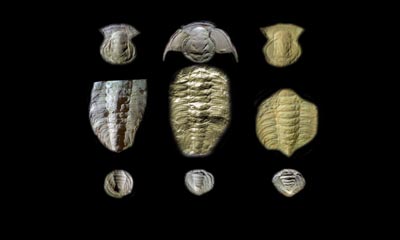 Click for a full size image!
Click for a full size image!
|
Free cheeks attached to cranidium and rescaled.
|
Trilobites - A few select key specimens of Type 1 (Zacanthoides walapai)
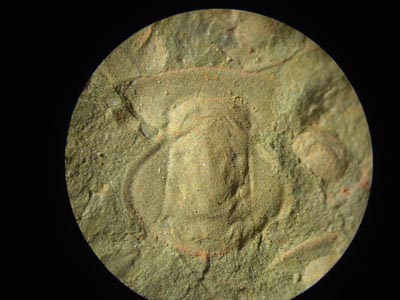 Click for a full size image!
Click for a full size image!
|
Cranidiums are flat and contain substantial palpebral lobes and a stout
cephalic border. A small hypostome appears to its right.
|
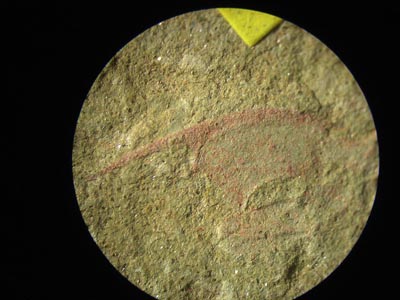 Click for a full size image!
Click for a full size image!
|
Free cheek (Librigena) with genial spine. Note the sharp edge to where the
eye would be attached at the bottom of the cheek. Zacanthoides had very
narrow eyes that were literally slits that could see 180 degrees. It would be
able to see the horizon but not above the animal.
|
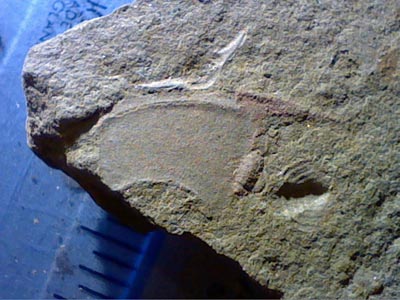 Click for a full size image!
Click for a full size image!
|
Another free cheek with genial spine. A very tiny (3mm) pygidium of a
juvinile is on its right. Smallest pygidums we found were 1mm.
|
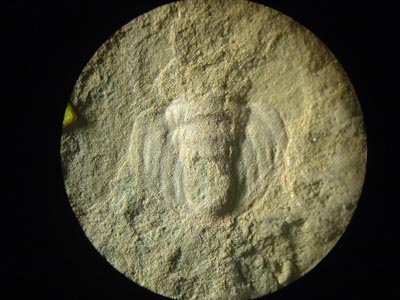 Click for a full size image!
Click for a full size image!
|
In this dime sized field, this pygidium shows a rounded axial lobe termination,
and fan-like furrows. This one has a rounded profile on the bottom.
|
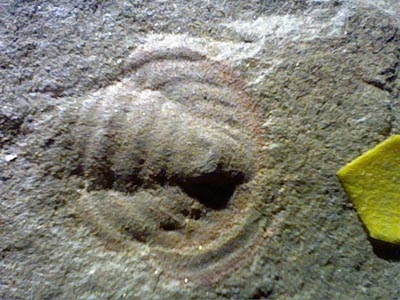 Click for a full size image!
Click for a full size image!
|
Another pygidium, very well preserved about 1 cm. A lip like border can be
seen here.
|
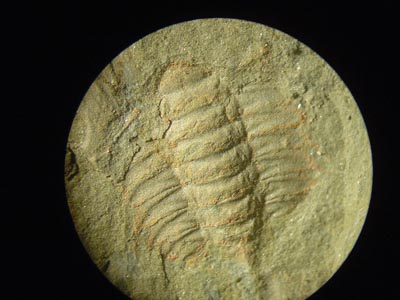 Click for a full size image!
Click for a full size image!
|
Thorax, the top forward end is complete with a nice articulating half ring. Note
the crisp axial and pleural furrows here!
|
Hypostomes (mouth cover plate)
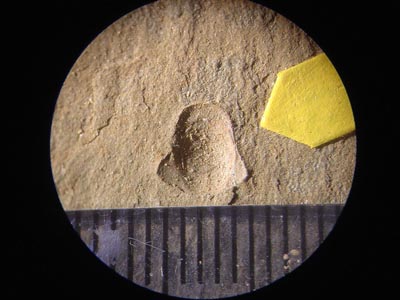 Click for a full size image!
Click for a full size image!
| This
is a nice external mold of a Zacanthoides hypostome. A large
number of these were found amongst the crandiums on the green
shale slabs. The size ranged from less than .1" to about.35"
in length. |
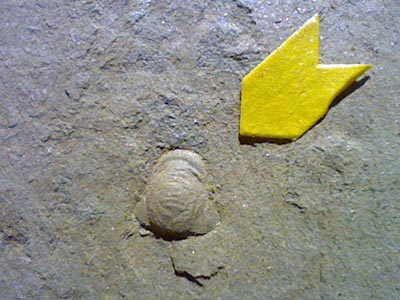 Click for a full size image!
Click for a full size image!
| Postitive
cast from a hollow mold preserving the external appearance in
three dimensions. This is a small specimen, the arrow is about
.2" wide. |
Trilobites - Type 2 - Amecephalus Althea
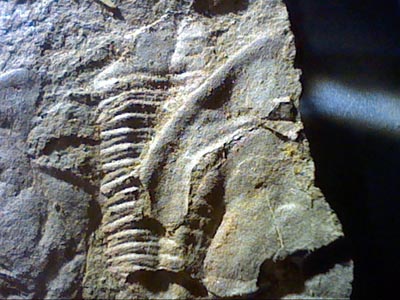 Click for a full size image!
Click for a full size image!
|
A major find was the type 2 trilobite which just over 50% of the body was
seen. This allows a digital reconstruction seen below to aid identification. The
cephlon of a much larger trilobite is overprinting it. The size is approximately
2 cm.
|
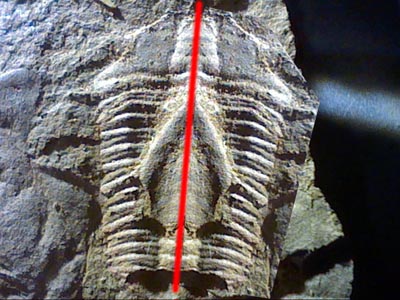 Click for a full size image!
Click for a full size image!
|
By digitally folding over the visible half, we can get a more complete picture
of what a compete specimen would have looked like. Note that this one even has
facets on its eyes!
|
 Paleo HOME
Paleo HOME
|